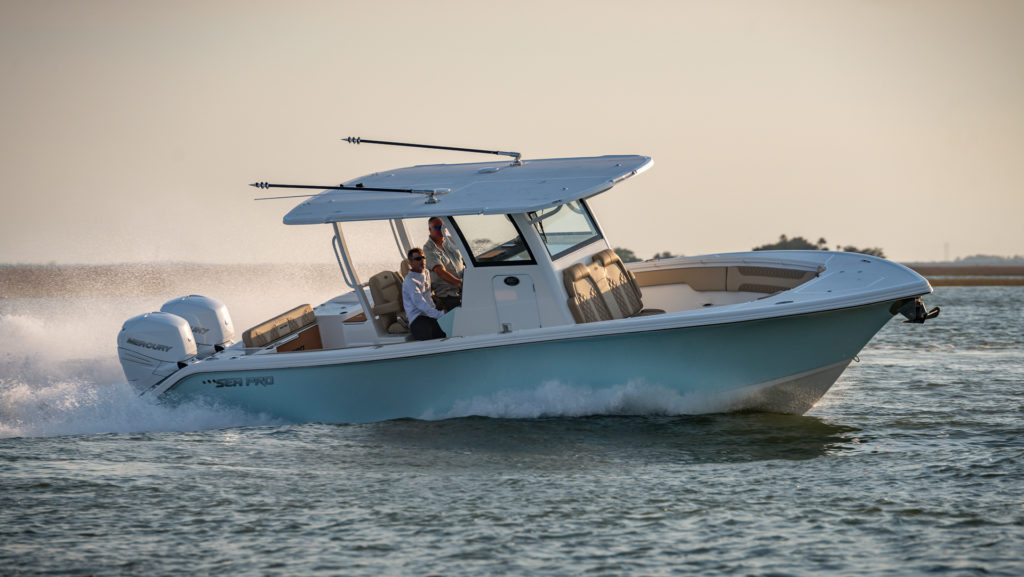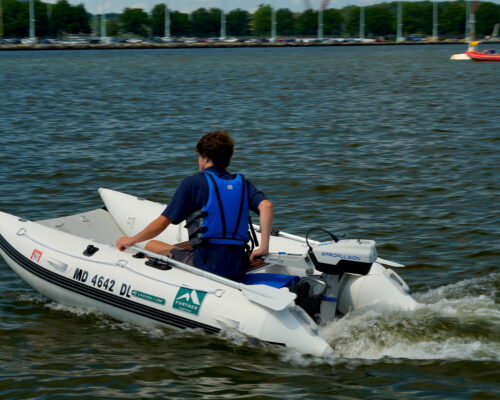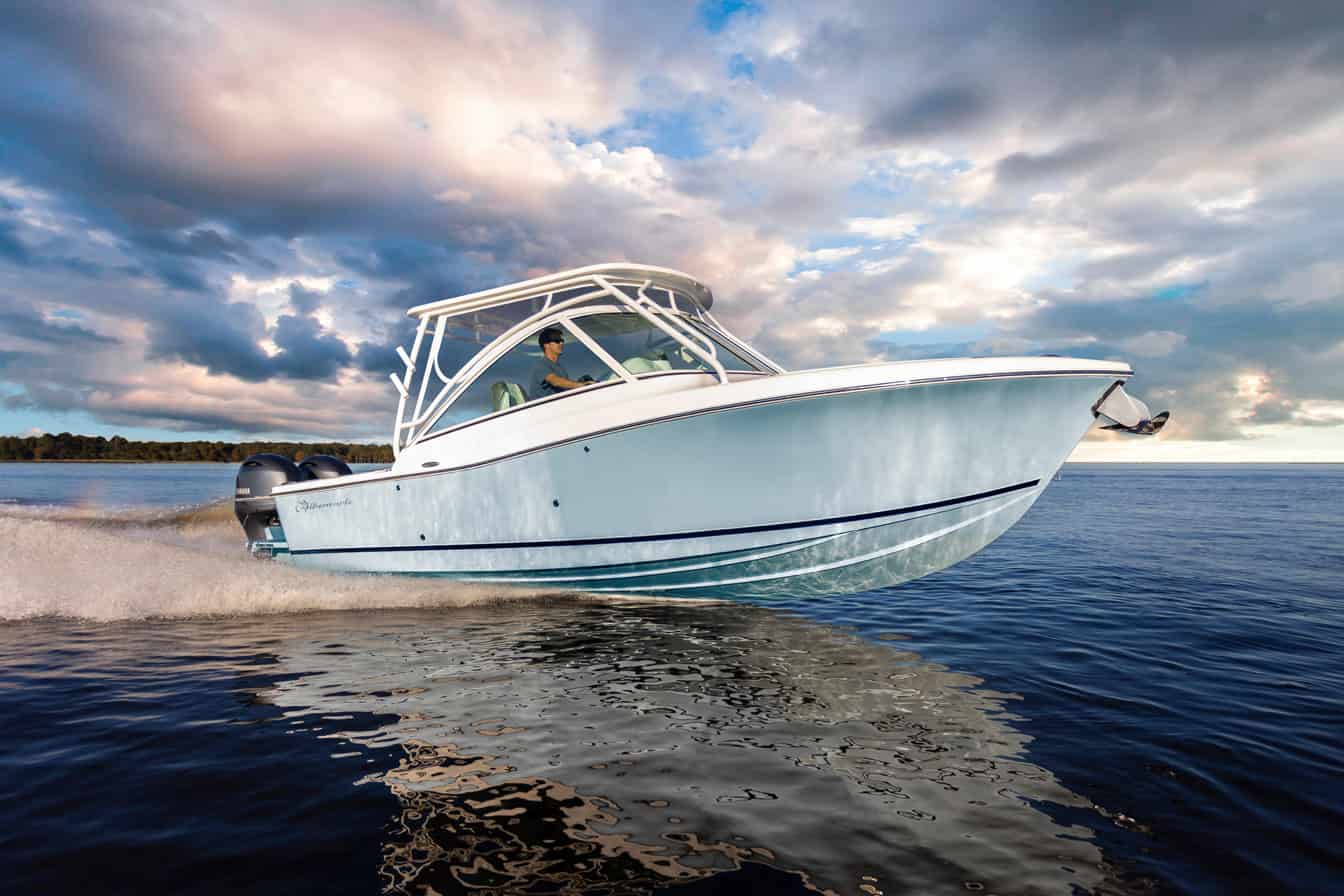By John Page Williams
We’re glad to see the Sea Pro brand settled back on the Chesapeake with two strong, service-oriented dealers, Tri-State Marine in Deale, Md. and Lynnhaven Marine in Virginia Beach. For those with long memories, the brand began with the Hancock family in South Carolina in 1987. The company built solid, reasonably priced center-console and bay boats until the 2000s, when the family sold it to Brunswick Corp., which continued to build until the Great Recession. Brunswick shut down Sea Pro then, along with several other boat brands. About five years ago, Jimmy Hancock and his friend Preston Wrenn, formerly of Tidewater Boats, resurrected the Sea Pro line as the next wave of center-console and bay boats.
We had a chance to crawl around several of their models at the United States Powerboat Show, and then took a sea trial several days later with Jim Reinoehl, a member of the Tri-State service team. We went aboard the company’s flagship 320 DLX Offshore center-console, out into Herring Bay and the open Chesapeake. While we could have wished for rougher seas to let the 320 show off, the day was lumpy enough to give us a good sense of how it performed at all speeds. Having Jim aboard was especially valuable for his expertise on installing and servicing the boat’s electronics, wiring, plumbing, and mechanical systems. That point of view is important for understanding how the boat will perform, not only when new but five or 10 years down the road.
One element that stood out quickly on the 320 DLX was the quality of the fittings. The anchor windlass at the bow, for example, is stout and firmly anchored in a finished compartment beneath a tight-fitting lid that’s finished on both sides. The cockpit side door mounts on massive stainless hinges with a strong, positive-locking latch. A folding swim ladder for the door is optional. It stores in a dedicated rack in the lid to the bilge. All hatch lids and hinges we looked at were mounted firmly. The swim ladder in the starboard corner of the transom platform is telescopic and stows horizontally in the platform. The grab handles in the hardtop frame are built for the human hand, with enough depth to get a good grip quickly and indentations for fingers. Lamination is sharp everywhere, including wave-shedding crisp edges on the chines and bottom strakes.
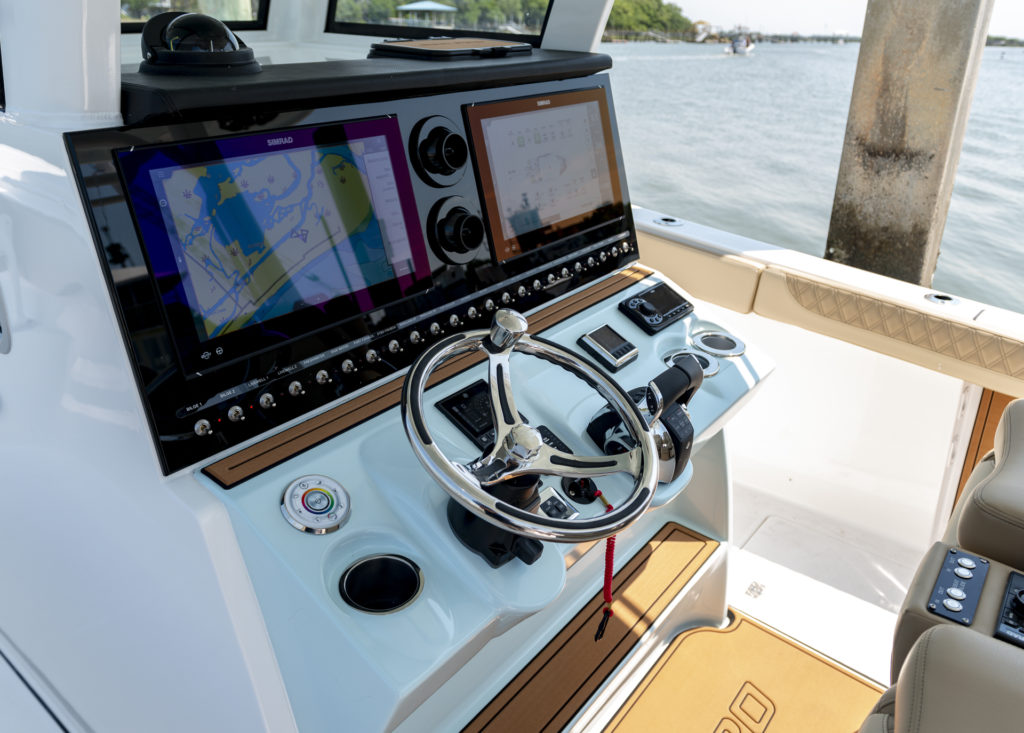
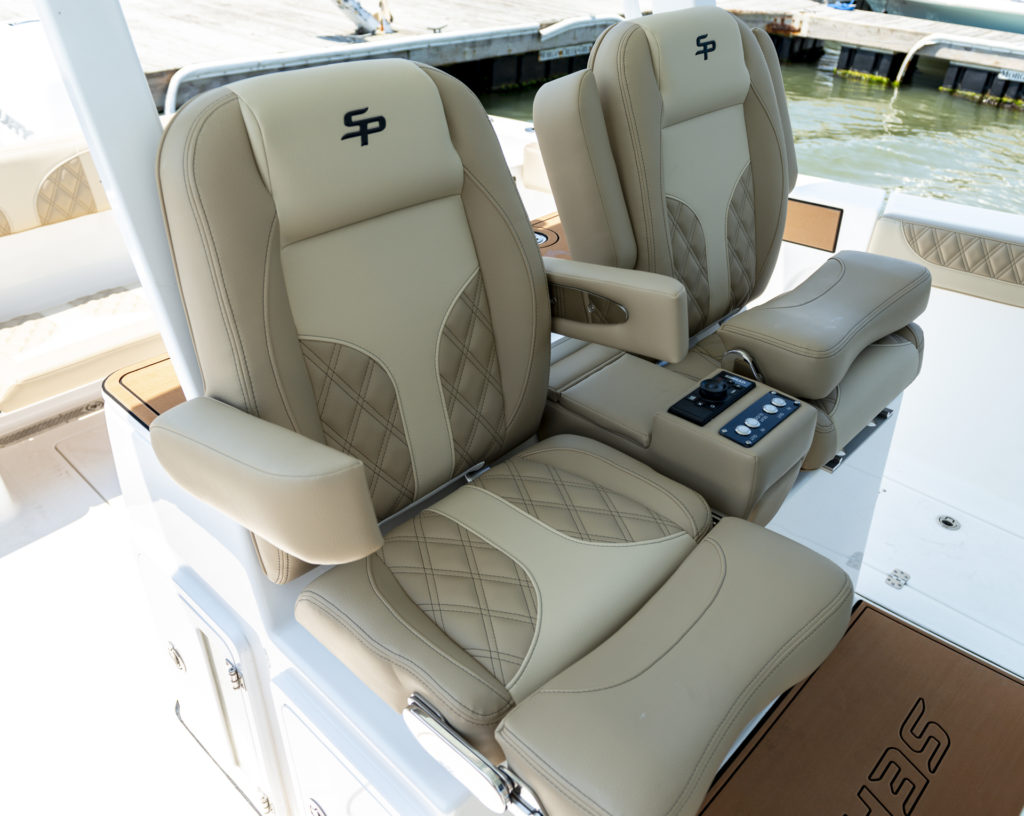
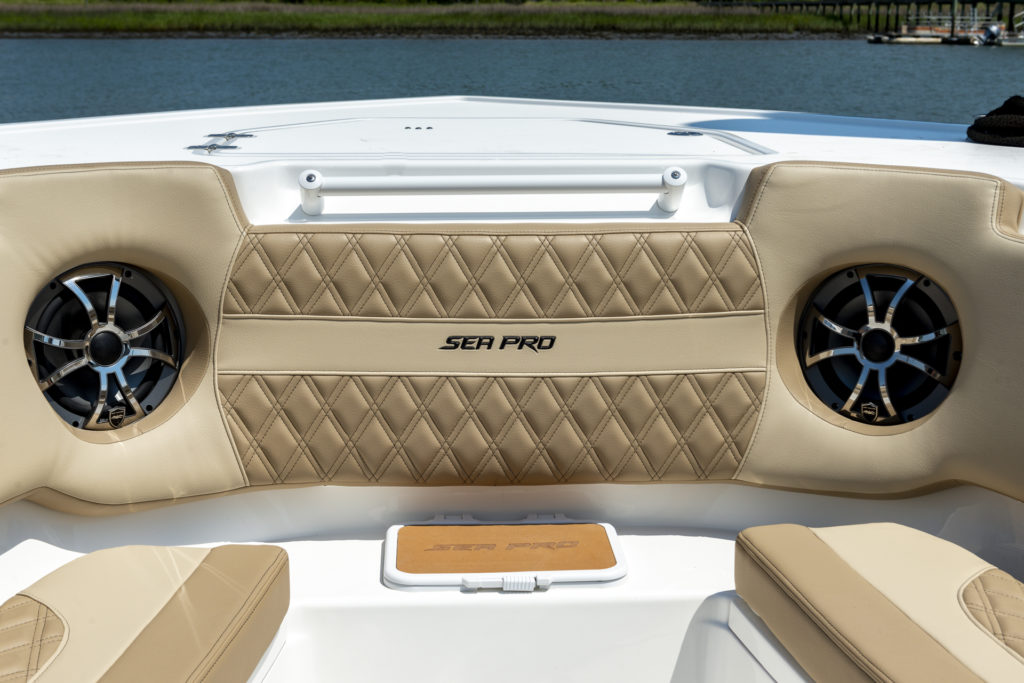
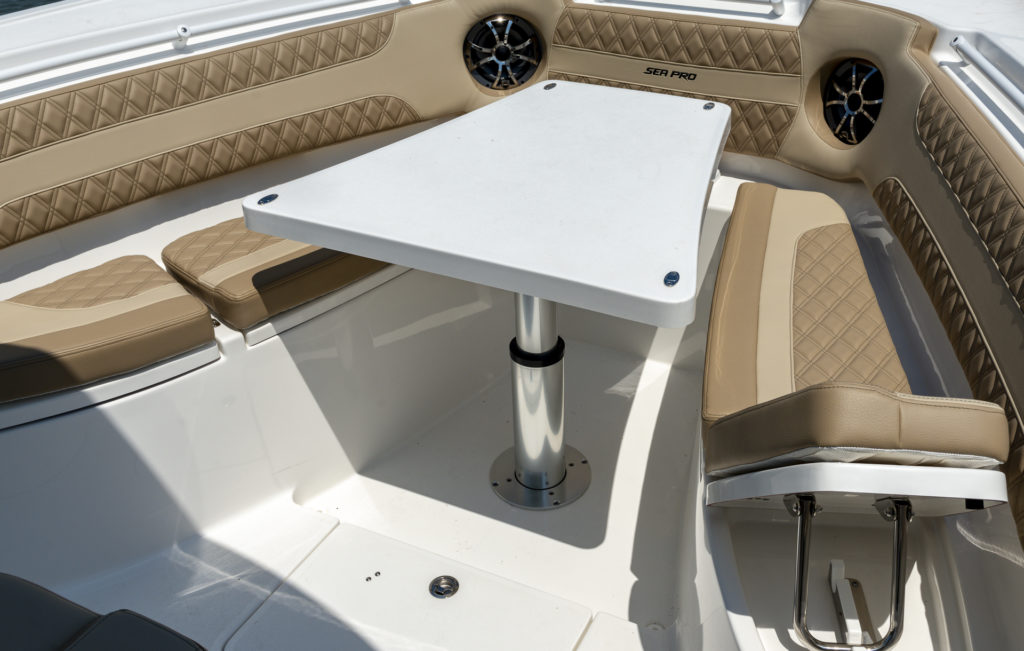
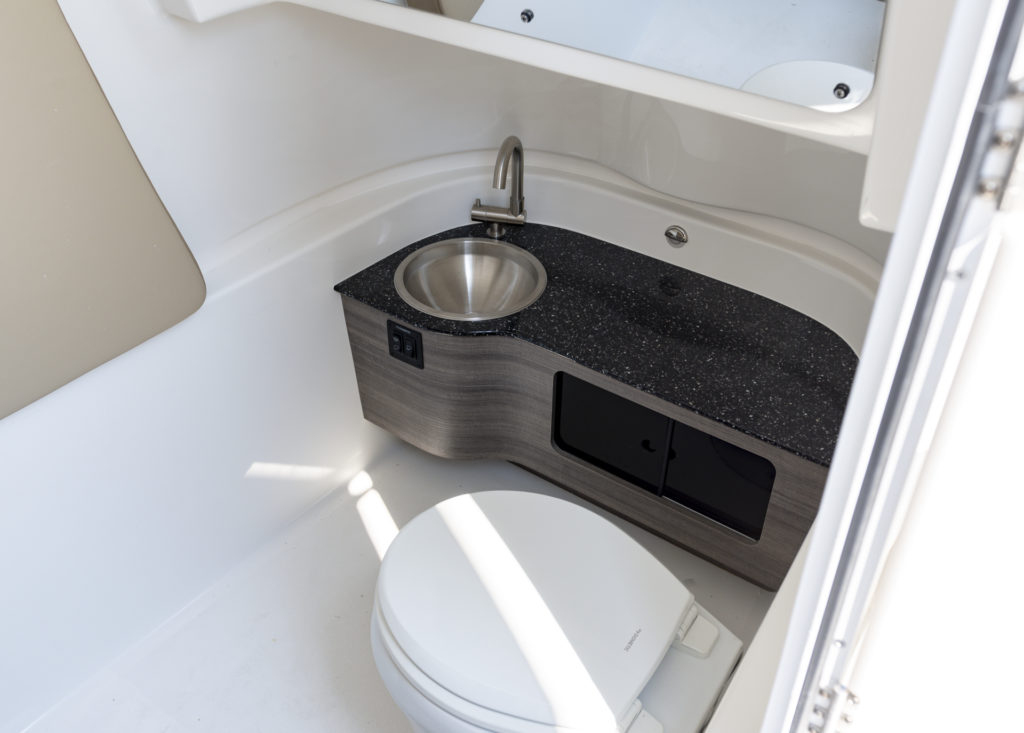
In accommodations, the Sea Pro design team clearly thinks in human dimensions. The 320 DLX’s console changing room offers easy access with well-placed grab handles and a wide door, 6’2″ headroom inside, a porcelain toilet with holding tank, a sink with pressure fresh water and counter, and a small bench seat with storage beneath. A large hatch above the bench provides a technician with easy access to the inside of the helm and its electronics. In the bow cockpit, an electrically actuated table can create a picnic table, a sunpad, or a casting/castnet-throwing deck, or return to the sole. Built into the deck in front of the table is an ingenious “dry box organizer” for sunglasses and phones that also includes a pair of 12-volt USB charging plugs. Around it are forward-facing lounges port and starboard, with a comfortable, cushioned seat for two facing forward on the front of the console, plus stereo speakers facing forward in the hardtop above. Sea Pro builds its own distinctive cushions in-house.
The business side of the helm features Optimus EPS steering, a tilt helm, and a stainless steering wheel with knob. Sea Pro worked with Boat Fix and Simrad to build a proprietary “Connect” boat control system based on NSO19 EVO3 electronic displays linked to a SS175 M Chirp Transducer on a black acrylic-glass bridge with a row of carefully labelled switches below. A key fob activates the system, but there is a master switch on the dash as well. Also mounted there are an Audison Audio System, an engine data display (Sea Pro rigs with Mercury, Suzuki, and Yamaha outboards), and trim tab controls. Options for the helm include an Optimus 360 Joystick w/Sea Station, an LED spotlight with wireless remote switch, Eskimo refrigerated cupholders, and a pair of MarineCool mister spray outlets. The large pad on the console’s top holds a compass to port and another dry box organizer. The hardtop holds a Simrad RS 40 VHF radio linked to the connect system and a storage box overhead.
The three-panel glass windshield (front and sides) protects the skipper and a companion, but the one gripe we had with the 320 DLX was that the windshield wiper does not sweep the lower third of the front panel. While no spray came aboard during our sea trial, some spits of rain remained on the glass, obstructing our view of the water immediately ahead.
The dual helm chairs operate electronically, with a control panel for them and the Simrad system in between. They each have flip-up arms and bolsters. Port and starboard beside the helm lie a pair of macerated fishboxes in the sole. The aft legs of the hardtop anchor the aft corners of the helm seat base. Underneath sits an 80-liter cooler on a positive-locking slide, and above is a 36″-wide freshwater sink with a hinged lid. The hardtop overhead holds a pair of speakers and an overhead freshwater shower that emanates from a stainless-steel grate. The aft edge of the hardtop and the transom each hold a rocket launcher for five fishing rods. The gunwales hold 11 more, and there are two horizontal racks recessed into the starboard topside of the aft cockpit, along with a toe rail. The forward face of the transom holds a fold-down, cushioned seat for two.
Jim Reinoehl enjoyed showing off the bilge under the aft cockpit sole. He lifted the large, finished hatch to reveal a steel grate for stepping down. The grate covers yet allows easy access to the boat’s series 31 batteries (an onboard 12/24/36/48-volt battery charging system is optional). The bilge is gel-coated, showing off massive stringers. In between sits a polished stainless-steel sea chest with two Bait Sentry pumps feeding 30-gallon pressurized livewells in the transom corners. The sea chest minimizes the number of through-hull fittings needed. The rest of the plumbing and wiring is neatly arranged and readily accessible for service. That includes the hoses connecting the crowned cockpit sole’s two screened drains to one-way scuppers built into the transom above the waterline. A Sea Pro engineer clearly thought about the 320 DLX’s need to self-bail at rest.
Sea Pro 320 DLX Offshore
LOA: 32′
Beam: 10’4″
Max HP: 800
Dry Weight: 8,500 lb.
Fuel Capacity: 207 gal.
Freshwater Capacity: 22 gal
Transom Deadrise: 24.5º
For more information, visit seapromfg.com
So how did this full-featured boat perform on a moderately snotty day? In a word, well. Reinoehl commented that he had run it back down to Deale in rougher conditions after the Powerboat Show in Annapolis and had been impressed with how solid it felt. It felt sturdy for us too, with no rattles or shakes as we ran it at all angles and several speeds into the seas, including the wakes of several charterboats headed back to harbor. Handling was crisp, easy, and dry, with a soft ride from the deep-V hull. It was easy to forget that the boat is 32′ long, though her length and weight clearly contributed to the ride quality. The twin Yamaha 300s on the transom provided solid, efficient performance, including low cruise at 22 kt. (4,000 rpm), high cruise at 27 kt. (4,500 rpm), and a top end of 42.5 kt. (6,000 rpm). We were also impressed that the 320 DLX rose onto plane easily at speeds in the mid-teens, suggesting a wide range of usable speeds to fit conditions. The boat was also very stable on the drift, despite its deep-V hull.
Base price for the 320 DLX Offshore with twin 300-hp Yamaha outboards is $310,668.
CBM Editor-at-Large, educator, guide, and author of three quintessential Chesapeake Bay books, Capt. John Page Williams was named a Maryland Admiral of the Bay in 2013.

